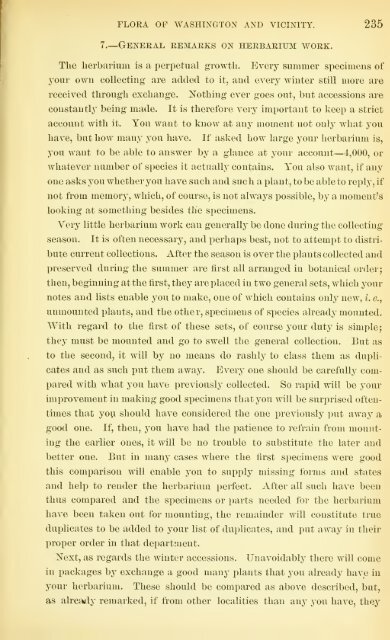Bulletin - United States National Museum - Smithsonian Institution
Bulletin - United States National Museum - Smithsonian Institution
Bulletin - United States National Museum - Smithsonian Institution
Create successful ePaper yourself
Turn your PDF publications into a flip-book with our unique Google optimized e-Paper software.
FLORA OF WASHINGTON AND VICINITY. 235<br />
7. General, remarks on herbarium work.<br />
The herbarium is a perpetual growth. Every summer specimens of<br />
your own collecting are added to it, and every winter still more are<br />
received through exchange. Nothing ever goes out, but accessions are<br />
constantly being made. It is therefore very important to keep a strict<br />
account with it. You want to know at any moment not only what you<br />
have, but how many you have. If asked how large your herbarium is,<br />
you want to be able to answer by a glance at your account—4,000, or<br />
whatever number of species it actually contains. You also want, if any<br />
one asks you whether you have such and such a plant, to be able to reply, if<br />
not from memory, which, of course, is not always possible, by a moment's<br />
looking at something besides the specimens.<br />
Very little herbarium work can generally be done during the collecting<br />
season. It is often necessary, and perhaps best, not to attempt to distri-<br />
bute current collections. After the season is over the plants collected and<br />
preserved during the summer are first all arranged in botanical order j<br />
then, beginning at the first, they are placed in two general sets, which your<br />
notes and lists enable you to make, one of which contains only new, i. e.,<br />
unmounted plants, and the other, specimens of species already mounted.<br />
With regard to the first of these sets, of course your duty is simple;<br />
they must be mounted and go to swell the general collection. But as<br />
to the second, it will by no means do rashly to class them as dupli-<br />
cates and as such put them away. Everj' one should be carefully com-<br />
pared with what you have previously collected. So rapid will be your<br />
improvement in making good specimens that you will be surprised often-<br />
times that you should have considered the one previously put away a<br />
good one. If, then, you have had the patience to refrain from mount-<br />
ing the earlier ones, it will be no trouble to substitute the later and<br />
better one. But in many cases where the first specimens were good<br />
this comparison will enable you to supply missing forms and states<br />
and help to render the herbarium perfect. After all such have been<br />
thus compared and the specimens or parts needed for the herbarium<br />
have been taken out for mounting, the remainder will constitute true<br />
duplicates to be added to your list of duplicates, and put away in their<br />
proper order in that department.<br />
Next, as regards the winter accessions. Unavoidably there will come<br />
in packages by exchange a good many i)lants that you already have in<br />
your herbarium. These should be compared as above described, but,<br />
as already remarked, if from other localities than any you have, they

















